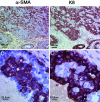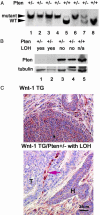Evidence that transgenes encoding components of the Wnt signaling pathway preferentially induce mammary cancers from progenitor cells
- PMID: 14668450
- PMCID: PMC307657
- DOI: 10.1073/pnas.2136825100
Evidence that transgenes encoding components of the Wnt signaling pathway preferentially induce mammary cancers from progenitor cells
Abstract
Breast cancer is a genetically and clinically heterogeneous disease, and the contributions of different target cells and different oncogenic mutations to this heterogeneity are not well understood. Here we report that mammary tumors induced by components of the Wnt signaling pathway contain heterogeneous cell types and express early developmental markers, in contrast to tumors induced by other signaling elements. Expression of the Wnt-1 protooncogene in mammary glands of transgenic mice expands a population of epithelial cells expressing progenitor cell markers, keratin 6 and Sca-1; subsequent tumors express these markers and contain luminal epithelial and myoepithelial tumor cells that share a secondary mutation, loss of Pten, implying that they arose from a common progenitor. Mammary tumors arising in transgenic mice expressing beta-catenin and c-Myc, downstream components of the canonical Wnt signaling pathway, also contain a significant proportion of myoepithelial cells and cells expressing keratin 6. Progenitor cell markers and myoepithelial cells, however, are lacking in mammary tumors from transgenic mice expressing Neu, H-Ras, or polyoma middle T antigen. These results suggest that mammary stem cells and/or progenitors to mammary luminal epithelial and myoepithelial cells may be the targets for oncogenesis by Wnt-1 signaling elements. Thus, the developmental heterogeneity of different breast cancers is in part a consequence of differential effects of oncogenes on distinct cell types in the breast.
Figures





References
-
- Morrison, B. W. & Leder, P. (1994) Oncogene 9, 3417-3426. - PubMed
-
- Cardiff, R. D., Anver, M. R., Gusterson, B. A., Hennighausen, L., Jensen, R. A., Merino, M. J., Rehm, S., Russo, J., Tavassoli, F. A., Wakefield, L. M., et al. (2000) Oncogene 19, 968-988. - PubMed
-
- Hedenfalk, I., Duggan, D., Chen, Y., Radmacher, M., Bittner, M., Simon, R., Meltzer, P., Gusterson, B., Esteller, M., Kallioniemi, O. P., et al. (2001) N. Engl. J. Med. 344, 539-548. - PubMed
Publication types
MeSH terms
Substances
Grants and funding
LinkOut - more resources
Full Text Sources
Other Literature Sources
Molecular Biology Databases
Research Materials
Miscellaneous

